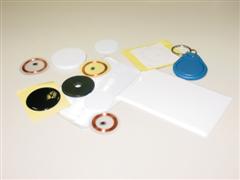Research
Introduction


Just like radios and cordless phones, RFID uses radio waves to transmit information; unlike radio and cordless phones, however, the information transmited is usually static and is stored on tags.
There are two different types of RFID tags. Passive tags are powered by the reader when they are in range. Active tags have their own power supply. Our project involves only passive tags.
RFID tags have several advantages over barcodes or magnetic strips. Tags do not need to be lined up precisely, they only have to be within the range of the reader, which depends on whether the tag is powered and the size of its antenna. Because they do not need to be lined up, tags can be read at a faster rate. To make things go even faster, some readers are capable of reading multiple tags at once.
The main disadvantage of RFID tags compared to barcodes or magnetic strips is cost; barcodes can be printed with an inkjet or laser printer.